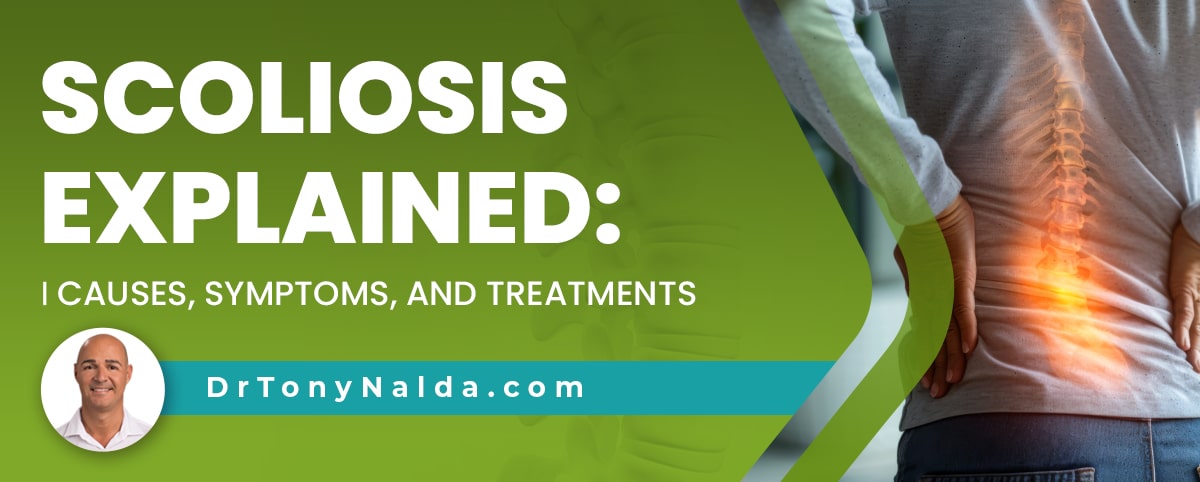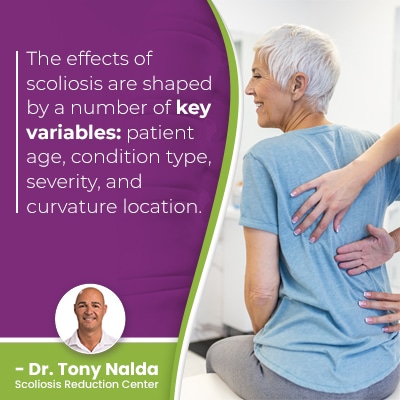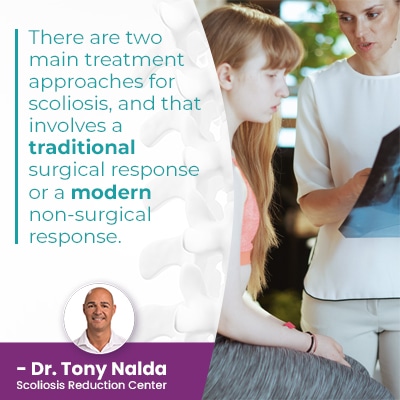Scoliosis Explained: Causes, Symptoms, and Treatments

Understanding scoliosis is important for those recently diagnosed, and if the spinal condition runs in the family, knowing the early signs of scoliosis can lead to early detection. There are no treatment guarantees, but certain factors, like early diagnosis, are associated with treatment success.
Early diagnosis is associated with treatment success; this is due to the progressive nature of scoliosis making it more complex to treat over time. Scoliosis symptoms and treatment needs are shaped by factors like patient age, condition type, severity, and curvature location.
As there are so many benefits associated with early detection and intervention, let's start with why.
Table of Contents
Early Detection
Scoliosis is diagnosed through a physical examination and X-ray results, and part of the diagnostic process involves comprehensive assessment to further classify conditions based on important factors.
Scoliosis isn't just a structural spinal condition that causes the spine to bend and twist unnaturally; it's also a progressive condition that's triggered by growth.
As a progressive condition, the nature of scoliosis is to get worse over time, and this means the size of the unnatural spinal curve is going to increase over time, and this makes scoliosis more complex to treat.
As a scoliotic curve gets larger, it's becoming more rigid, and a spine that's not flexible is one that's not going to respond as well to treatment.
Increasing spinal rigidity also makes it difficult for some patients to perform key therapeutic exercises as part of treatment.
In addition, as scoliosis progresses, the uneven forces of the condition are increasing, as are their effects.
With progressive conditions like scoliosis, it's more effective to proactively work towards preventing progression and increasing effects than it is to attempt to reverse the effects once they're established; sometimes when treatment is started can be as important as the type of treatment applied.
Effects of Scoliosis
 The effects of scoliosis are shaped by a number of key variables: patient age, condition type, severity, and curvature location.
The effects of scoliosis are shaped by a number of key variables: patient age, condition type, severity, and curvature location.
As a progressive condition, the effects of scoliosis are always changing, and the longer a condition is left untreated, or the more a condition progresses, the more pronounced, and difficult to reverse, the condition's effects are likely to be.
Postural Changes
In childhood scoliosis, the main effects involve postural changes as the condition disrupts the body's overall symmetry.
In many cases of childhood scoliosis, the earliest signs of scoliosis include uneven shoulders and uneven hips; additional changes can include the development of a rib cage arch, arms and legs that appear to hang at different lengths, uneven hips, and changes to balance, coordination, and gait.
Scoliosis Pain
In adults, the main symptom of scoliosis that brings them in to see me for a diagnosis and treatment is pain, and this is because scoliosis doesn't become a compressive condition until skeletal maturity has been reached; it's compression of the spine and its surrounding muscles and nerves that causes the majority of condition-related pain.
In young patients whose spines are still growing, the constant lengthening motion of growth can counteract the compressive force of the unnatural spinal curve, and this is a challenge to early detection of childhood scoliosis; in addition, when mild, scoliosis isn't commonly associated with functional deficits and it's postural changes can be subtle.
Scoliosis pain that's related to compression can involve back pain, muscle pain, and pain that radiates into the extremities due to nerve compression.
The longer these types of effects are left unaddressed, the more established they become, and it takes more effort to address.
If scoliosis is left untreated, or isn't treated proactively, complications can develop such as digestive issues and breathing problems.
As a progressive condition, it's important for patients to understand that where their condition is, and its effects, at the time of diagnosis doesn't indicate that's where it will stay.
Because of the condition's complex and progressive nature, how a diagnosis is responded to with treatment is key.
Scoliosis Treatment Options
There are two main treatment approaches for scoliosis, and that involves a traditional surgical response or a modern non-surgical response.
Traditional treatment is reactive; it doesn't start immediately following a diagnosis because it doesn't have a strategy for addressing scoliosis while mild and is more about responding once a certain amount of progression has occurred.
In many cases, if a patient's progression pushes them into the severe classification, spinal fusion surgery is commonly recommended as the best remaining treatment option.
Spinal fusion surgical treatment involves the removal of discs that sit between adjacent vertebrae to be fused, and fusing the curve's most-tilted vertebrae into one solid bone so they can't become more unnaturally tilted over time (progression).
Fusing the spine, however, is contrary to its movement-based design and can leave patients disappointed with the reduced range of motion and spinal flexibility they are left with.
The reality is that a fused spine is weaker and more vulnerable to injury, less flexible, and pain at the fusion site can also occur.
There are also significant risks associated with the procedure itself: nerve damage, infection, adverse reaction to hardware used, and excessive blood loss.
Non-Surgical Scoliosis Treatment
 The success of non-surgical scoliosis treatment shows that not all cases of scoliosis need surgery.
The success of non-surgical scoliosis treatment shows that not all cases of scoliosis need surgery.
Conservative non-surgical treatment is proactive and integrative; it's started as close to the time of diagnosis as possible and combines the power of multiple scoliosis-specific treatment disciplines so conditions can be impacted on every level.
While we don't always know what causes scoliosis to develop initially, we do know how to treat it effectively and manage its progressive nature; scoliosis can be highly treatable, particularly with early detection and intervention.
Here at the Scoliosis Reduction Center®, conservative treatment involves condition-specific chiropractic care, physical therapy, scoliosis exercises, corrective bracing, and rehabilitation.
The Power of Integration
When treatment is integrative, it can be customized as the different facets of treatment can be adjusted accordingly based on how the spine is responding to treatment and growth (childhood scoliosis).
Conservative treatment combines the power of multiple scoliosis-specific types of treatment so conditions can be impacted on every level.
Condition-specific chiropractic care can include a number of techniques and manual adjustments that work together to realign the spine, and this is impacting the condition's underlying structural nature.
Physical therapy and scoliosis exercises can help maintain spinal flexibility and increase the strength of the spine's surrounding muscles for better support and stability.
Physical therapy and scoliosis exercises can also help improve posture, pain, and muscle balance; an effect of scoliosis is a muscular imbalance.
Scoliosis introduces uneven forces to the body, and as the unnatural spinal curve is pulling the spine's surrounding muscles in different directions, muscles on one side can become weak from underuse while muscles on the other side can become stretched and sore from overuse.
Scoliosis Bracing
Corrective bracing can help push spines into a straighter alignment, particularly in childhood scoliosis as growing spines are more malleable, and rehabilitation includes custom-prescribed exercises to help patients further heal and stabilize their spines from home.
Continued chiropractic care can also be necessary, as is guidance on how to lead a scoliosis-friendly lifestyle.
Conclusion
With close to seven million people with scoliosis living in the United States alone, the condition is highly prevalent and warrants awareness.
Scoliosis is also the leading spinal condition among school-aged children, and as progression is triggered by growth, children are at risk for rapid progression, hence childhood scoliosis should always be taken seriously.
When explaining scoliosis, I want to clearly communicate the benefits of early detection and the fact that not all cases of scoliosis have to be treated with surgery.
Spinal surgery is risky and invasive and comes with some serious potential risks, side effects, and complications, so should be considered carefully.
The most important thing to understand about scoliosis is that its progressive nature means its effects are likely to become more severe over time and that starting treatment early in a condition's progressive line is the best way to prevent scoliosis from getting worse.
As scoliosis progresses, it becomes more difficult to treat, and depending on the type of scoliosis, treatment might have to include some preparatory work to increase the spine's flexibility to make it more responsive.
The most common type of scoliosis diagnosed is idiopathic scoliosis and, this accounts for approximately 80 percent of known diagnosed cases, and the remaining 20 percent consists of types with known causes: neuromuscular scoliosis, degenerative scoliosis, and congenital scoliosis.
A spinal deformity like scoliosis doesn't just affect the spine, but its surroundings, and the entire body, so conditions need to be treated proactively and effectively.
As early detection can set patients on a path toward treatment success, scheduling a screening examination can be the first step.
Dr. Tony Nalda
DOCTOR OF CHIROPRACTIC
After receiving an undergraduate degree in psychology and his Doctorate of Chiropractic from Life University, Dr. Nalda settled in Celebration, Florida and proceeded to build one of Central Florida’s most successful chiropractic clinics.
His experience with patients suffering from scoliosis, and the confusion and frustration they faced, led him to seek a specialty in scoliosis care. In 2006 he completed his Intensive Care Certification from CLEAR Institute, a leading scoliosis educational and certification center.
About Dr. Tony Nalda
 Ready to explore scoliosis treatment? Contact Us Now
Ready to explore scoliosis treatment? Contact Us Now





